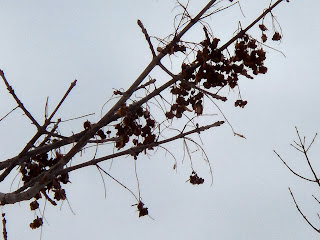 |
| ASH TREES HAVE OPPOSITE BRANCHES |
 |
| FORMAL SHAPE OF YOUNG WHITE ASH TREE |
 |
| PENDULOUS BRANCHES OF GREEN ASH TREE |
 |
| DEFORMED, PERSISTENT MALE FLOWERS |
Blog reader Tim Jet, of Tree Nursery Company in Tennessee, after reading the October 5, 2013 post "Ash Species Fall Leaf Color," commented that I should give some hints for winter ash tree identification as well, since Emerald Ash Borer is such a prevalent problem. So here goes.
Ash trees have opposite branching rather than alternate, and that is the most prominent winter identification clue. Maples and a few other trees (mainly horse chestnut, Ohio buckeye and flowering dogwood) also have opposite branching, but the ash branchlets are much thicker than maple branchlets. Buckeye and horse chestnut branchlets are relatively shorter and stubbier than ash branchlets, and dogwoods don't become large trees.
Of the most common ash trees, the winter profile of a young to middle-aged white ash tree is very formal, the branches sweeping up and outward. The winter profile of a green ash tree is more irregular, and the branches are pendulous, sweeping downward.
In ash species, the trees are male and female, the female flowers developing into a winged samara ( a hard, small nutlet) which look much like the winged samaras of maple trees except that the seed has only one wing, while the maple has two seeds joined together so they appear to have two wings. The seeds often persist on the tree into winter (I will find an example and add a photo). The male flowers of ash species often are infested by a tiny mite which distorts the flowers and they are quite obvious in winter; where there are a lot of ash trees in a forest this can be quite a good distance identification characteristic, with often fifty-percent of the ash trees identifiable in this way.
There are other winter identifying characteristics, such as trunk bark, and dormant branch leaf scars, the later I think too complicated for this discussion.
Tree Nursery Company.com has a nice web site with color photos, and I encourage Almanac readers to look it up.











No comments:
Post a Comment